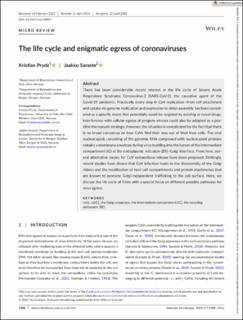| dc.contributor.author | Prydz, Kristian | |
| dc.contributor.author | Saraste, Jaakko | |
| dc.date.accessioned | 2023-03-10T14:23:44Z | |
| dc.date.available | 2023-03-10T14:23:44Z | |
| dc.date.created | 2022-10-19T10:21:04Z | |
| dc.date.issued | 2022 | |
| dc.identifier.issn | 0950-382X | |
| dc.identifier.uri | https://hdl.handle.net/11250/3057771 | |
| dc.description.abstract | There has been considerable recent interest in the life cycle of Severe Acute Respiratory Syndrome Coronavirus-2 (SARS-CoV-2), the causative agent of the Covid-19 pandemic. Practically every step in CoV replication—from cell attachment and uptake via genome replication and expression to virion assembly has been considered as a specific event that potentially could be targeted by existing or novel drugs. Interference with cellular egress of progeny viruses could also be adopted as a possible therapeutic strategy; however, the situation is complicated by the fact that there is no broad consensus on how CoVs find their way out of their host cells. The viral nucleocapsid, consisting of the genomic RNA complexed with nucleocapsid proteins obtains a membrane envelope during virus budding into the lumen of the intermediate compartment (IC) at the endoplasmic reticulum (ER)–Golgi interface. From here, several alternative routes for CoV extracellular release have been proposed. Strikingly, recent studies have shown that CoV infection leads to the disassembly of the Golgi ribbon and the mobilization of host cell compartments and protein machineries that are known to promote Golgi-independent trafficking to the cell surface. Here, we discuss the life cycle of CoVs with a special focus on different possible pathways for virus egress. | en_US |
| dc.language.iso | eng | en_US |
| dc.publisher | Wiley | en_US |
| dc.rights | Attribution-NonCommercial-NoDerivatives 4.0 Internasjonal | * |
| dc.rights.uri | http://creativecommons.org/licenses/by-nc-nd/4.0/deed.no | * |
| dc.title | The life cycle and enigmatic egress of coronaviruses | en_US |
| dc.type | Journal article | en_US |
| dc.type | Peer reviewed | en_US |
| dc.description.version | publishedVersion | en_US |
| dc.rights.holder | Copyright 2022 the authors | en_US |
| cristin.ispublished | true | |
| cristin.fulltext | original | |
| cristin.qualitycode | 2 | |
| dc.identifier.doi | 10.1111/mmi.14907 | |
| dc.identifier.cristin | 2062640 | |
| dc.source.journal | Molecular Microbiology | en_US |
| dc.source.pagenumber | 1308-1316 | en_US |
| dc.identifier.citation | Molecular Microbiology. 2022, 117 (6), 1308-1316. | en_US |
| dc.source.volume | 117 | en_US |
| dc.source.issue | 6 | en_US |

